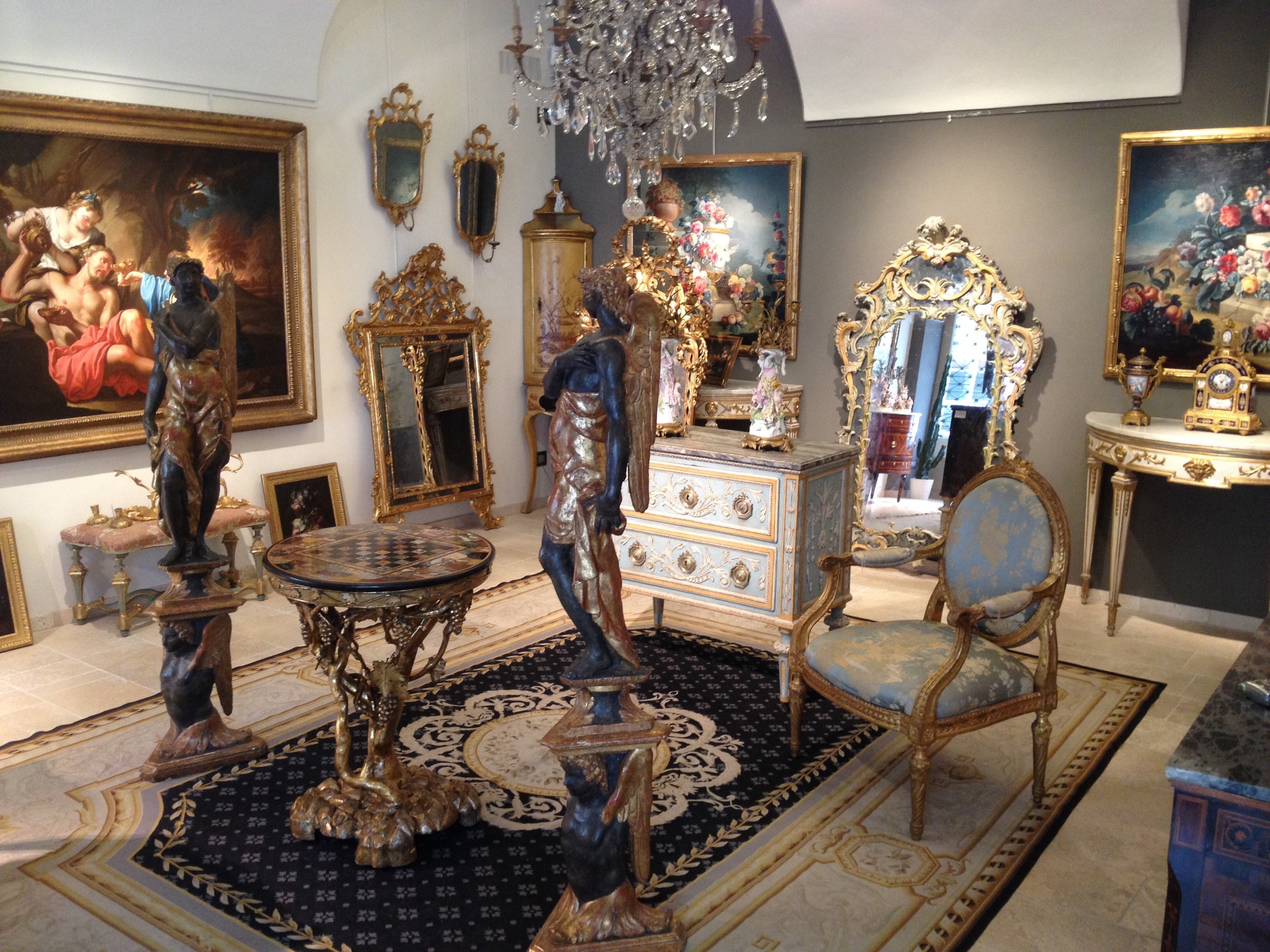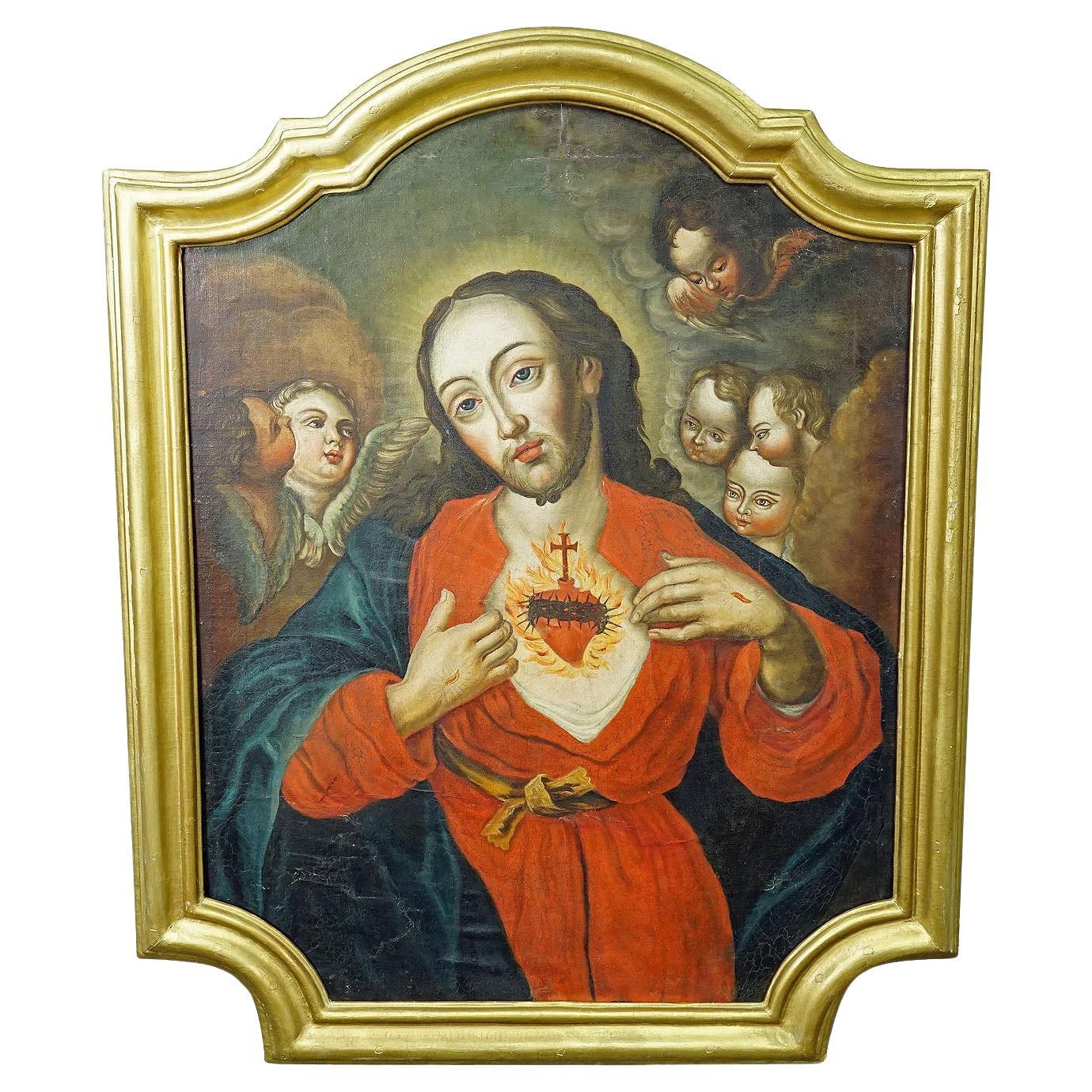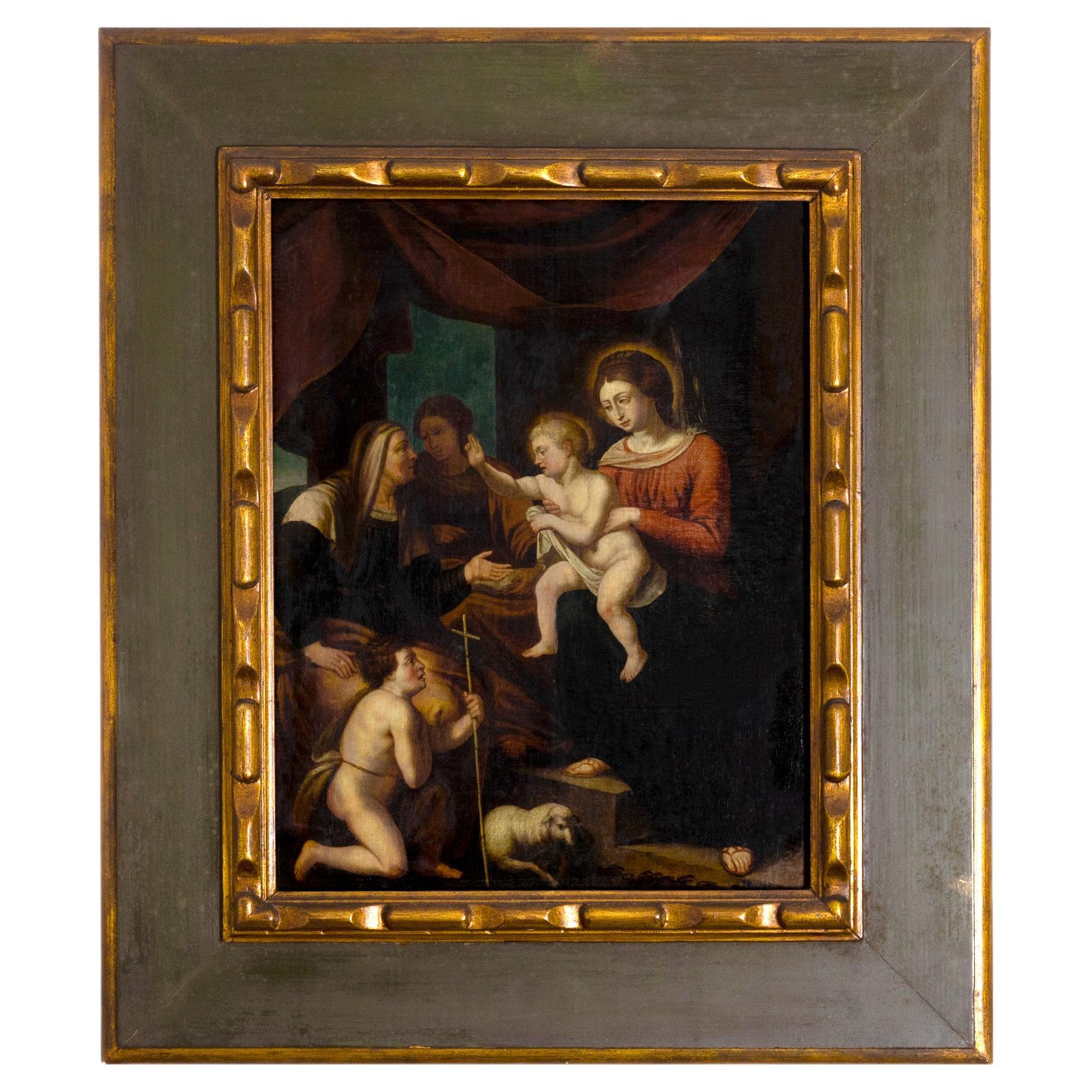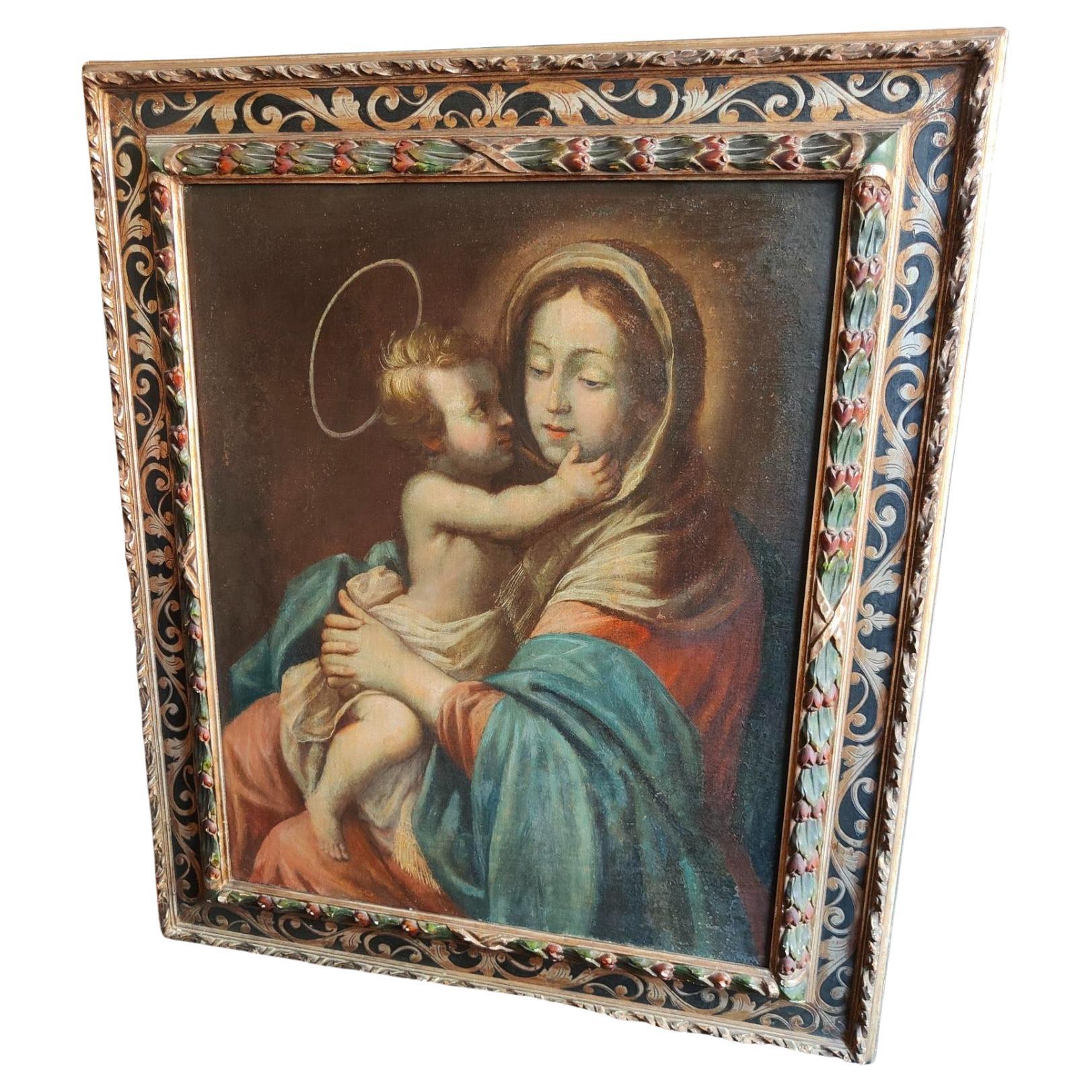Items Similar to 18th Century, Italian painting with Sacred Heart of the Child Jesus by Pietro Ba
Want more images or videos?
Request additional images or videos from the seller
1 of 19
18th Century, Italian painting with Sacred Heart of the Child Jesus by Pietro Ba
About the Item
Pietro Bardellino (Italy - Naples, 1732 - 1806), attr., Sacred Heart of the Child Jesus
Measurements: with frame, cm L 86 x H 99 x P 8; only the canvas, cm L 78 x H 64
The painting, made in oil on canvas, represents the Sacred Heart of the Child Jesus. Stylistically the work is attributable to Pietro Bardellino (Italy, Naples, 1732 - Naples, 1806), a pupil of Francesco De Mura and considered by critics one of the most gifted and sensitive exponents of the Rococo style in Naples.
The canvas represents the Child Jesus, surrounded by flowers in an outdoor setting, while showing the sacred heart. The canvas has a well-balanced color and a strong sweetness of the child’s traits, which with the complicit gesture of the right hand, involves the viewer in the intimate and delicate sharing of the garden in which he sits. The roses, in addition to being a beautiful piece of still life, contribute to enrich the Christological message, being bearers of symbolic meanings. Marian attributes par excellence, are often side by side with Christ, whose thorns foreshadow the Passion. In the canvas, on the top left, two cherubim are observed: among them, according to the Old Testament, is God: the author therefore puts into place an iconographic and iconological hyperbole that amplifies its meaning. The iconographic theme of the Child Jesus with the Sacred Heart in his hand spread between the second half of the eighteenth century and the first of the following century. With the worship of the Sacred Heart of Jesus, the Catholic Church intends to honour the Heart of Jesus Christ, one of the organs symbolizing his humanity, which by intimate union with the Divinity, has the right to worship and love of the Saviour for men, of which His Heart is the symbol. It represents one of the fundamental devotions of Christian life, as it manifests the true face of God, who is prodigal and boundless love. It was the French mystic Saint Margaret Mary Alacoque (Verosvres, July 22, 1647 - Paray-le-Monial, October 17, 1690) the messenger of worship, which in 1856 Pope Pius IX extended to the whole Catholic Church. The subject depicted here therefore respects an established traditional iconography. Below are some known examples of such representations, which we see being spread throughout the Italian territory although in a number of works quite small enough to consider this image rare and sporadic.
Stylistically the work is attributable to one of the best students of Francesco de Mura: Pietro Bardellino. The painter was born in Naples in 1731; there is little information about his artistic training and his activity before 1756, the year in which he decorated the ceiling of the pharmacy of the Incurables. With his later works he fits into the pictorial tradition of the followers of Solimena, while showing that he knows the manner of Giacomo del Po, derived from Luca Giordano. In 1773 he became a member of the Academy of Fine Arts, called by Luigi Vanvitelli and in 1779 was appointed master of the Royal Academy of Drawing and Painting. A staunch follower of traditional painting, he remained indifferent to the stimuli of neoclassicism, which penetrated the Neapolitan environment in various ways, preferring to express themselves through an imaginative manner, rich in bright colors and luminosity effects. In the old apartment of the Royal Palace of Caserta, seven of his paintings, made in mature age and representing Science and the Arts, Peace and War, Innocence, Simplicity, Truth, Day, Night, are testimony to harmony, of pictorial airiness and of the vigorous chromatic palette, characterized by lively chiaroscuro, which are its own. Attentive to the trends of North European art of great fashion at the court of Maria Carolina of Saxony, wife of Ferdinand IV, the painter lightens the compositions of his master, explaining an elegant Rococo taste in a southern key. In 1803 he was entrusted, together with Desiderio De Angelis, with the nude school at the Academy, then directed by G. B. Wicar; the post was confirmed by the Napoleonic government in 1806, the year of his death.
The canvas object of this study presents a stylistic setting and a chromatic palette very close to many works by Bardellino with games of putti per subject. Similar characteristics can be observed, such as the combination of pink with intense blue, the deep looks of the subjects depicted and the softness of the trait with which the painter describes the plump bodies of Bambinelli and putti.
We apologize for any errors in translation from Italian.
- Attributed to:Pietro Bardellino (Artist)
- Dimensions:Height: 38.98 in (99 cm)Width: 33.86 in (86 cm)Depth: 3.15 in (8 cm)
- Style:Baroque (Of the Period)
- Materials and Techniques:
- Place of Origin:
- Period:
- Date of Manufacture:Mid-18th Century
- Condition:Wear consistent with age and use.
- Seller Location:IT
- Reference Number:1stDibs: LU4405225241672

About the Seller
5.0
Gold Seller
These expertly vetted sellers are highly rated and consistently exceed customer expectations.
Established in 1980
1stDibs seller since 2019
41 sales on 1stDibs
Typical response time: 1 hour
- ShippingRetrieving quote...Ships From: Italy
- Return PolicyA return for this item may be initiated within 7 days of delivery.
More From This SellerView All
- 18th Century, Italian Oval Painting by Pietro D Ollivero with Historical SubjectLocated in ITPainting by Pietro Domenico Ollivero. "Manio Annio Curio Dentato receives the ambassadors of the Samnites", around 1740 The work in question depicts the scene of and was made by the famous italian painter Pietro Domenico Ollivero. The oval canvas shows on the back the card of the Galleria Caretto in Turin (Italy) with the authentic 1965 Giorgio Caretto. The work was also published in "I Piaceri e le grazie" by Arabella Cifani and Franco Monetti in 1993. The subject refers to the history of Rome and an episode narrated by the historian Valerio Massimo. Manius Curius Dentatus (330 BC - 270 BC), one of the great Romans of the 3rd century B.C. was a consul in ancient Rome, known for ending the Samnite Wars. Elected consul in 290 BC. along with Publio Cornelio Rufino, in the same year he fought and won the Third War against the Samnites and their allies, thus ending a conflict that had lasted for 49 years. He definitively subdued the Sabines and the Greek army of Pyrrhus in the battle of Benevento. He represented the ideal prototype of ancient Roman for the generations that followed in that he avoided public honours; Cato the censor, who collected his sayings, placed him among the great figures of universal history. For centuries after his death (in 270 B.C. while overseeing the construction of the second aqueduct in Rome) his military exploits were recounted and his moral rectitude was praised as an example for all the Romans. Ollivero, in the cultured choice of the episode, illustrates the moment when Manio Curio Dentato is found in his home, characterized by Roman walls, sitting by the fire, on a rustic bench while eating his meal in a "ligneo catillo" (wooden basin...Category
Antique 1740s Italian Baroque Paintings
MaterialsCanvas
- 18th Century, Italian Oil on Canvas Still Life by Pietro NavarraLocated in IT18th century, Italian oil on canvas still life by Pietro Navarra Oil on canvas, canvas measures: cm H 103 x W 164, framed measures...Category
Antique 18th Century Italian Baroque Paintings
MaterialsCanvas
- 17th Century, Italian Painting with Virgin and Child by Follower of Van DyckBy Anthony van DyckLocated in IT17th century, Italian painting with virgin and childr by Follower of Sir Anthony van Dyck cm W 90 x H 113; cornice cm W 111 x H 135 x D 7 The canvas depicts the Madonna with the Chi...Category
Antique Late 17th Century Italian Baroque Paintings
MaterialsCanvas
- 18th Century, Italian Oil on Canvas Painting with Landscape with RuinsLocated in IT18th century, Italian oil on canvas painting with landscape with ruins Measures: only the canvas cm W 97.5 x H 108; with the frame cm W 103.5 x H 114 x D 5 The fine oil on canv...Category
Antique 18th Century Italian Baroque Paintings
MaterialsCanvas
- 18th Century Italian Oil on Canvas Painting with Battle by Antonio CalzaBy Antonio CalzaLocated in ITAntonio Calza (Italy, Verona, 1653-18th April 1725) "Battle between Christian and Turkish cavalry with castle" The painting depicts a bloody battle between Christian and Turkish cavalry. Characterized by dynamism, intensity of color and light, the main scene occupies the lower horizontal section of the canvas, optically interrupted by the black fumes of the shots from which emerge, on the left, the towers of a fortress. On the right, in the distance you can see the combat in progress in the countryside, beyond which you can see the pale presence of hills that create a fifth, marking the horizon. To frame the scene contributes to the left, against light and in the foreground, a portion of the wall. The painter, however, introduces a horse on the ground, of which we see only the back, a ruse to involve the observer making him become active and participate in the scene. In the foreground, lifeless bodies, wounded horses and, scattered on the ground, weapons and a drum enhance the drama of the clash. The excitement and expressive force, the intense chromatic range attentive to the conditions of light and the fine brushstrokes, decisive and dramatic, suggests the attribution to Antonio Calza, one of the most important painters of battles of the seventeenth century, excellent student and continuator of the greatest interpreter of the genre, Jacques Courtois called il Borgognone (Saint-Hyppolite 1621 - Rome 1676). Il Borgognone, although not having had a real school or direct students, places itself as a primary reference point by the Italian and foreign "battaglisti". The genre of battle painting found great success in the collections of the Italian and European nobility of the seventeenth and eighteenth centuries. The battles of the Italian Renaissance, in which the scene converged towards a precise protagonist, evolve towards a type of combat "without hero". The bloody realism of the details and the dynamic development of the narrative confuse the figure of the protagonist, when present, to give importance to the swirl of horses and armed fighters, among which, moreover, does not emerge a winner. The certain documents relating to the life and movements of Antonio Calza are scarce; it was equally difficult to reconstruct, from the critics, a catalogue of autograph works. Through paintings in private collections, in museums and paintings passed on the antiques market it has been possible to identify a copious corpus of works that can be traced back to his hand. The work of art historians, together with that of antique dealers, in conferring proper attributions in order to best outline the figure of Calza, continues but studies are still in progress. In this sense, the work of Giancarlo Sestieri should certainly be noted, who investigated the artistic production of the battaglisti and Calza, thus allowing the comparison of the numerous photographic works reported, to identify and recognize the stylistic qualities that distinguish the corpus of paintings assigned to him today. Antonio Calza was born in 1653 in Italy, in Verona and in 1664 he entered the school of Carlo Cignani in Bologna, dedicating himself to painting battles and landscapes. He then perfected in Rome, where he knew the works of the then undisputed head of the sector, Jacques Courtois called the Burgundian. In 1675 he returned to Verona and married an 88-year-old widow who, dying, left him a rich inheritance. Much appreciated by the nobility and the bourgeoisie, he received numerous commissions. Bartolomeo Dal Pozzo (Le Vite de' pittori, de gli scultori et architetti veronesi, 1718) praises "three great paintings of battles...Category
Antique Late 17th Century Italian Baroque Paintings
MaterialsCanvas
- 18th Century, Italian Pair of Oil on Canvas Paintings by Francesco SimoniniBy SIMONINILocated in ITFrancesco Simonini (Parma, 16 June 1686 - Parma, 1766) “The rest of the soldiers” and “The march of soldiers” oil on canvas The very fine paintings, attributable to the painte...Category
Antique Early 18th Century Italian Baroque Paintings
MaterialsCanvas
You May Also Like
- The Sacred Heart of Jesus, Oil Painting on Canvas 18th centuryLocated in Berghuelen, DEThe Sacred Heart of Jesus, Oil Painting on Canvas 18th century An antique oil painting depicting the sacred heart of Jesus. Oil on canvas with p...Category
Antique Early 18th Century German Baroque Paintings
MaterialsCanvas, Wood
- Our Lady with the Child Jesus 18th Century Italian SchoolBy Europa AntiquesLocated in Madrid, ESOur Lady with the Child Jesus 18th century Italian school according to model by Reni Guido. Oil on canvas DIM.: 45 x 37 cm good conditions.Category
Antique 18th Century Italian Baroque Paintings
MaterialsPaint
- Painting Saint John The Baptist Child Jesus, 18th CenturyLocated in Lisbon, PTA Flemish School painting of the Adoration of the Child Jesus in the hands of Mary and a young Saint John the Baptist at his feet kneeling with the cross side by side with a resting ...Category
Antique 18th Century Dutch Baroque Paintings
MaterialsWood
- Saint Joseph Jesus Baroque Painting, 18th CenturyLocated in Lisbon, PTA 17th Century painting of Joseph with the Child Jesus on his lap, a rare Baroque motif of paternal love. Oil on wood Frame: 47x54 cm Without frame: 27x34 cmCategory
Antique 18th Century Italian Baroque Paintings
MaterialsWood
- Painting, Madonna with Child, Period, 18th CenturyLocated in Alba, ITPainting, oil on canvas depicting the Madonna with child from the 18th century, painting of excellent pictorial quality. Nice Size painting and very good proportions. Pleasantly brig...Category
Antique 18th Century Italian Other Paintings
MaterialsPaint
- Antonio Allegri, Our Lady with the Child Jesus 16th CenturyBy Antonio da CorreggioLocated in Madrid, ESAntonio Alegri, (Correggio - 1494-1534) Our Lady with the Child Jesus oil on copper, Italian School 16th century With inscription on the back '1494-1534 Antonio Alegri, (Corregio) Lo...Category
Antique 16th Century Italian Baroque Paintings
MaterialsCopper
Recently Viewed
View AllMore Ways To Browse
18th Century Baroque Painting
Italian Baroque Painting
Heart Key
Love Sacred
18th Century Mens
French School 18th Century
French Baroque Painting
Sacred Heart
North Carolina Mid Century
18th Century Oil Paintings Small
Italian Mid Century Outdoor
Italian Mid Century Outdoor Furniture
Baroque Heart
Child Jesus
Jesus And Child
Baroque Christian
Christ With Child
18th Jesus





